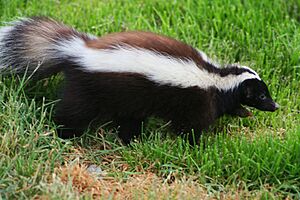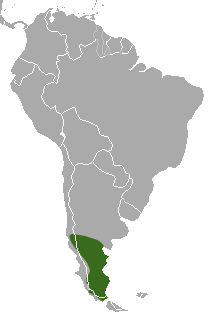Humboldt's hog-nosed skunk facts for kids
Quick facts for kids Humboldt's hog-nosed skunk |
|
|---|---|
 |
|
| Conservation status | |
| Scientific classification | |
| Genus: |
Conepatus
|
| Species: |
humboldtii
|
 |
|
| Humboldt's hog-nosed skunk range | |
The Humboldt's hog-nosed skunk (Conepatus humboldtii) is also called the Patagonian hog-nosed skunk. This interesting animal lives in the open grasslands of Patagonia. You can find it in parts of Argentina and Chile. It's a type of skunk, and it belongs to a group of animals called Carnivora.
Contents
What Does It Look Like?
This skunk is quite small and has a stocky body. Its nose is bare and long, which helps it sniff out food. It often looks for insects like ground beetles, grasshoppers, and crickets.
Its fur is brownish-red. It has two stripes that run down its back and continue onto its tail. These skunks are about 30 to 34 centimeters (12 to 13 inches) long. Their tails add another 17 to 21 centimeters (7 to 8 inches) to their length. They usually weigh between 1.5 to 3 kilograms (3.3 to 6.6 pounds).
The Humboldt's hog-nosed skunk has long claws and strong front legs. These are perfect for digging into the ground to find its prey.
Teeth for Eating Insects
This skunk's teeth are special. They are made for eating insects and fruits. Its lower molars (back teeth) are strong. They can crush tough foods like hard insect shells. Other animals, like the South American gray fox, have similar teeth.
Compared to skunks in North America, the South American hog-nosed skunks are smaller. They also have a simpler skull and tooth structure.
Where It Lives and Its Neighbors
Humboldt's hog-nosed skunks live in open, grassy areas. But they have to be careful! Bigger meat-eating animals often hunt them. This is called intraguild predation, where animals that eat similar things hunt each other.
Some of these bigger hunters include the culpeo (a type of fox), the chilla fox, Geoffrey's cat, pampas cat, Andean cat, and the puma. Even though these animals might hunt the skunk, the skunk usually doesn't hunt other meat-eaters.
What Does It Eat?
Humboldt's hog-nosed skunks are omnivorous. This means they eat both plants and animals. Their main food is insects.
During winter, when insects are harder to find, they also eat other things. They might eat small animals like rodents. They also eat carrion, which is the meat of dead animals. These skunks are also known to enjoy eating fruit.
Unlike some other meat-eating animals in South America, these skunks are not affected much by changes in food sources. This is because they mostly stick to eating insects.
How It Behaves
Humboldt's hog-nosed skunks are crepuscular. This means they are most active during dawn (early morning) and twilight (evening). They don't usually chase after their food. Instead, they look for prey that is easy to catch.
When winter comes and insects become scarce, these skunks change their habits. They move from open grasslands to shrubs, forests, or mountains. This helps them find different kinds of food when insects are not around.
About Its Name
The species was named by John Edward Gray. He named it to honor Alexander von Humboldt, a famous explorer.
Scientists sometimes debate if the Humboldt's hog-nosed skunk is a separate species from the C. chinga skunk. They look very similar. Their colors and patterns can vary a lot, and these differences are not always clear. Many of the differences in their size and shape might be due to where they live.
Studies of their skulls also show that their features overlap a lot. In 2021, a group called the American Society of Mammalogists decided that C. humboldtii is actually the same species as C. chinga.


